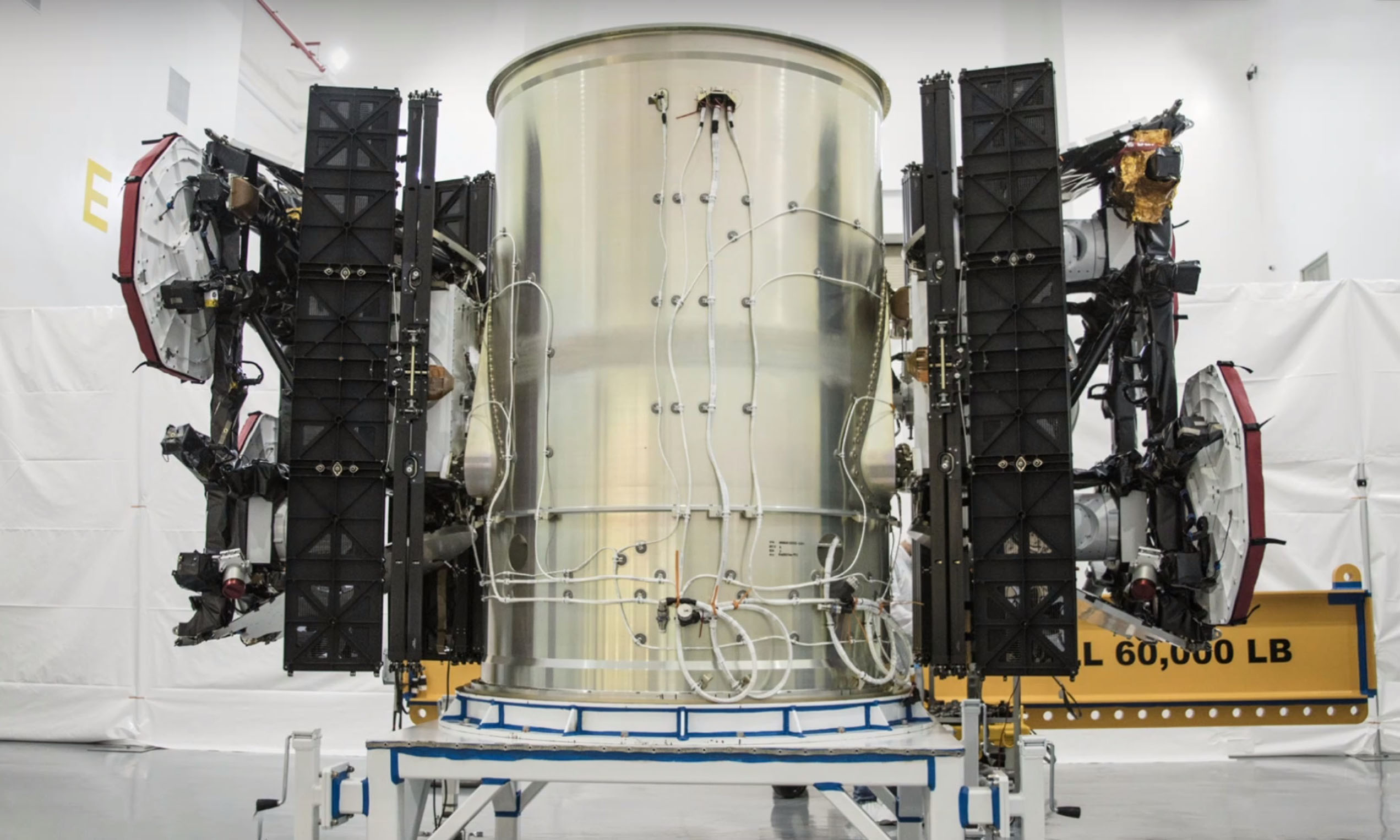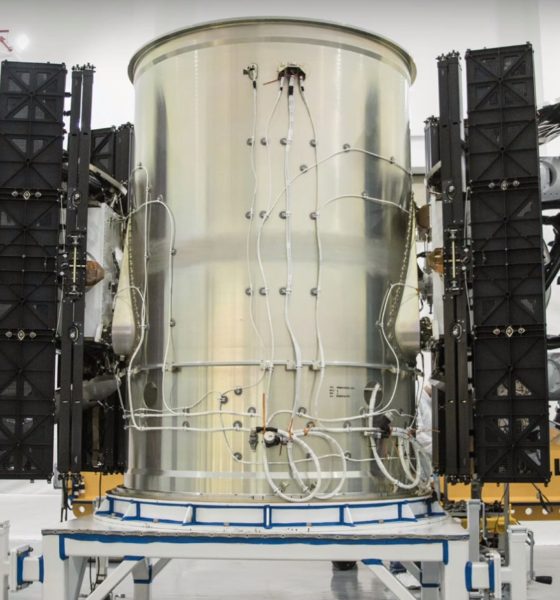

News
SpaceX’s first batch of Starlink satellites already in Florida for launch debut
According to an official statement, SpaceX’s satellite mass production is “well underway” and the first batch of operational Starlink satellites are already in Florida for their May 2019 launch debut.
Simultaneously, the FCC has granted SpaceX’s request to modify the deployment of its first 1584 Starlink satellites, permitting the company to lower their orbit from approximately 1150 km to 550 km (715 mi to 340 mi). A lower insertion orbit should improve Falcon 9’s maximum Starlink payload, while the lower operational orbit will help to further minimize any risk posed by orbital debris that could be generated by failed SpaceX satellites.
Above all else, SpaceX’s confirmation that the first batch of Starlink satellites are already in Florida drives home the reality that the company’s internet satellite constellation is about to become very real. Said constellation has long been the subject of endless skepticism and criticism, dominated by a general atmosphere of dismissal. There is no doubt that Starlink, as proposed, is an extraordinarily ambitious program that will cost billions of dollars to even begin to realize. SpaceX will have to find ways to affordably manufacture and launch ~11,900 satellites – together weighing something like 500 metric tons (1.1 million lbs) – in as few as nine years, start to finish.
As of November 2018, there are roughly 2000 satellites operating in Earth orbit, meaning that SpaceX’s full Starlink constellation would increase the number of functional satellites in orbit by a factor of almost seven. Just the first phase of Starlink (4409 satellites) would more than triple the number of working satellites in orbit. To meet the contractual requirement that SpaceX launch at least half of Starlink’s licensed satellites within six years of the FCC granting the constellation license, the company will need to launch an average of ~37 satellites per month between now and April 2024. By April 2027, SpaceX will either have to launch all ~2200 remaining Phase 1 satellites or risk forfeiture of its Starlink constellation license. Same goes for the ~7500 very low Earth orbit (VLEO) satellites making up Starlink’s second phase, albeit with their launch deadlines instead in November of 2024 and 2027.

In fact, if SpaceX wants to preserve the separate FCC license for its VLEO Starlink segment, it will actually need to build and launch an average of 100 satellites per month – 20+ per week – for the next five years. In no way, shape, or form is the monthly production of 100 complex pieces of machinery unprecedented. It is, however, entirely unprecedented – and by a factor of no less than 10 – in the spaceflight and satellite industries. Accomplishing that feat will require numerous paradigm shifts in satellite design, manufacturing, and operations. It’s hard to think of anyone more up to the challenge than SpaceX but it will still be an immensely difficult and expensive undertaking.
“Baby” steps
According to SpaceX, the first 75 operational Starlink satellites will be significantly less refined than those that will follow. Most notably, they will eschew dual-band (Ku and Ka) phased array antennas, instead relying solely on Ka-band communications. The second main difference between relates to “demisability”, referring to characteristics exhibited during reentry. The first 75 spacecraft will be less refined and thus feature a handful of components that are expected to survive the rigors of reentering Earth’s atmosphere, creating a truly miniscule risk of property damage and/or human injuries. Subsequent Starlink vehicles will incorporate design changes to ensure that 100% of each satellite is incinerated during reentry, thus posing a ~0% risk on the ground.
In a sense, the first 75 Starlink satellites will be an in-depth demonstration of SpaceX’s proposed constellation. Depending on how the satellites are deployed in orbit, SpaceX’s development team could potentially have uninterrupted access to the orbiting mini-constellation. There will also be constant opportunities to thoroughly test SpaceX’s network architecture for real, including general downlink/uplink traffic, surge management, satellite handoffs, and the laser interlinks meant to join all Starlink satellites into one giant mesh network.

SpaceX has yet to announce the precise number of Starlink satellites that will be aboard Falcon 9 on the rocket’s first dedicated internal launch. More likely than not, the constraining factor will be the usable volume of SpaceX’s payload fairing, measuring 5.2m (17 ft) in diameter. For Flight 1, 10-20 satellites is a reasonable estimate. Likely to weigh around 10,000 kg (22,000 lb) total, the first Starlink payload will be delivered to a parking orbit of ~350 km (220 mi), easily allowing Falcon 9 to return to SpaceX’s Florida Landing Zone or perform a gentle landing aboard drone ship Of Course I Still Love You (OCISLY). The satellites will use their own electric Hall thrusters to reach their final destination (550 km).
According to SpaceX CEO Elon Musk, the first Falcon 9 fairing reuse may also happen during an internal Starlink launch, although it’s unclear if he was referring to Starlink Launch 1 (Starlink-1) or a follow-up mission later this year.
For now, SpaceX is targeting a mid-May for its first dedicated Starlink mission, set to launch from Launch Complex 40 (LC-40). Up next for LC-40 is SpaceX’s 17th operational Cargo Dragon launch (CRS-17), delayed from April 26th and April 30th to May 3rd.
Check out Teslarati’s Marketplace! We offer Tesla accessories, including for the Tesla Cybertruck and Tesla Model 3.

News
Tesla FSD fleet is nearing 7 billion total miles, including 2.5 billion city miles
As can be seen on Tesla’s official FSD webpage, vehicles equipped with the system have now navigated over 6.99 billion miles.

Tesla’s Full Self-Driving (Supervised) fleet is closing in on almost 7 billion total miles driven, as per data posted by the company on its official FSD webpage.
These figures hint at the massive scale of data fueling Tesla’s rapid FSD improvements, which have been quite notable as of late.
FSD mileage milestones
As can be seen on Tesla’s official FSD webpage, vehicles equipped with the system have now navigated over 6.99 billion miles. Tesla owner and avid FSD tester Whole Mars Catalog also shared a screenshot indicating that from the nearly 7 billion miles traveled by the FSD fleet, more than 2.5 billion miles were driven inside cities.
City miles are particularly valuable for complex urban scenarios like unprotected turns, pedestrian interactions, and traffic lights. This is also the difference-maker for FSD, as only complex solutions, such as Waymo’s self-driving taxis, operate similarly on inner-city streets. And even then, incidents such as the San Francisco blackouts have proven challenging for sensor-rich vehicles like Waymos.
Tesla’s data edge
Tesla has a number of advantages in the autonomous vehicle sector, one of which is the size of its fleet and the number of vehicles training FSD on real-world roads. Tesla’s nearly 7 billion FSD miles then allow the company to roll out updates that make its vehicles behave like they are being driven by experienced drivers, even if they are operating on their own.
So notable are Tesla’s improvements to FSD that NVIDIA Director of Robotics Jim Fan, after experiencing FSD v14, noted that the system is the first AI that passes what he described as a “Physical Turing Test.”
“Despite knowing exactly how robot learning works, I still find it magical watching the steering wheel turn by itself. First it feels surreal, next it becomes routine. Then, like the smartphone, taking it away actively hurts. This is how humanity gets rewired and glued to god-like technologies,” Fan wrote in a post on X.
News
Tesla starts showing how FSD will change lives in Europe
Local officials tested the system on narrow country roads and were impressed by FSD’s smooth, human-like driving, with some calling the service a game-changer for everyday life in areas that are far from urban centers.

Tesla has launched Europe’s first public shuttle service using Full Self-Driving (Supervised) in the rural Eifelkreis Bitburg-Prüm region of Germany, demonstrating how the technology can restore independence and mobility for people who struggle with limited transport options.
Local officials tested the system on narrow country roads and were impressed by FSD’s smooth, human-like driving, with some calling the service a game-changer for everyday life in areas that are far from urban centers.
Officials see real impact on rural residents
Arzfeld Mayor Johannes Kuhl and District Administrator Andreas Kruppert personally tested the Tesla shuttle service. This allowed them to see just how well FSD navigated winding lanes and rural roads confidently. Kruppert said, “Autonomous driving sounds like science fiction to many, but we simply see here that it works totally well in rural regions too.” Kuhl, for his part, also noted that FSD “feels like a very experienced driver.”
The pilot complements the area’s “Citizen Bus” program, which provides on-demand rides for elderly residents who can no longer drive themselves. Tesla Europe shared a video of a demonstration of the service, highlighting how FSD gives people their freedom back, even in places where public transport is not as prevalent.
What the Ministry for Economic Affairs and Transport says
Rhineland-Palatinate’s Minister Daniela Schmitt supported the project, praising the collaboration that made this “first of its kind in Europe” possible. As per the ministry, the rural rollout for the service shows FSD’s potential beyond major cities, and it delivers tangible benefits like grocery runs, doctor visits, and social connections for isolated residents.
“Reliable and flexible mobility is especially vital in rural areas. With the launch of a shuttle service using self-driving vehicles (FSD supervised) by Tesla in the Eifelkreis Bitburg-Prüm, an innovative pilot project is now getting underway that complements local community bus services. It is the first project of its kind in Europe.
“The result is a real gain for rural mobility: greater accessibility, more flexibility and tangible benefits for everyday life. A strong signal for innovation, cooperation and future-oriented mobility beyond urban centers,” the ministry wrote in a LinkedIn post.
News
Tesla China quietly posts Robotaxi-related job listing
Tesla China is currently seeking a Low Voltage Electrical Engineer to work on circuit board design for the company’s autonomous vehicles.

Tesla has posted a new job listing in Shanghai explicitly tied to its Robotaxi program, fueling speculation that the company is preparing to launch its dedicated autonomous ride-hailing service in China.
As noted in the listing, Tesla China is currently seeking a Low Voltage Electrical Engineer to work on circuit board design for the company’s autonomous vehicles.
Robotaxi-specific role
The listing, which was shared on social media platform X by industry watcher @tslaming, suggested that Tesla China is looking to fill the role urgently. The job listing itself specifically mentions that the person hired for the role will be working on the Low Voltage Hardware team, which would design the circuit boards that would serve as the nervous system of the Robotaxi.
Key tasks for the role, as indicated in the job listing, include collaboration with PCB layout, firmware, mechanical, program management, and validation teams, among other responsibilities. The role is based in Shanghai.
China Robotaxi launch
China represents a massive potential market for robotaxis, with its dense urban centers and supportive policies in select cities. Tesla has limited permission to roll out FSD in the country, though despite this, its vehicles have been hailed as among the best in the market when it comes to autonomous features. So far, at least, it appears that China supports Tesla’s FSD and Robotaxi rollout.
This was hinted at in November, when Tesla brought the Cybercab to the 8th China International Import Expo (CIIE) in Shanghai, marking the first time that the autonomous two-seater was brought to the Asia-Pacific region. The vehicle, despite not having a release date in China, received a significant amount of interest among the event’s attendees.








